|
In between the more sombre
dances, relief is provided by performers in the guise of
skeletons who perform comic and acrobatic feats.
|
| The centuries-old culture of Ladakh has found expression in its
monuments, monasteries, tradition of oral literature, art
forms, fairs and festivals.
|
| | |
|
As the `Chhams' approaches the climax, the votive offering is
a grotesque human figure made of dough which is ritually
dismembered. This is traditionally done by `Jha Nak', or the
leader of the Black Hat dancers. He then scatters the pieces
in the four cardinal directions. This act has many
interpretations: cleansing of the soul, the dissolution of the
human body after death, a re-enactment of the assassination of
the Tibetan apostate king Lang-dar-ma by a Buddhist monk in AD
842.

Life and After Life
The rites and ceremonies of the festival are conducted by the
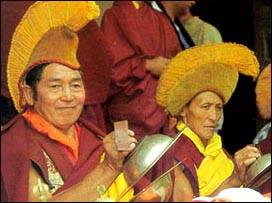 `Rimpoche' or Head Lama, incarnate of the monastery. He
occupies a high throne in the centre of the verandah at one
side of the rectangular courtyard. Other lamas sit on either
side of the throne on carpet-covered straw mattresses,
according to their hierarchy. The Lamas recite mantras
associated with various episodes of Chhams' under the
`Rimpoche's direction, thus creating the right ambience for
devotees to imbibe the religious significance of the dances.
According to traditional belief, the appearance of the masked
dancers serves to familiarise the devotees with the kind of
divinities they are expected to encounter during the 49-day,
`Bardo' (or transit) period between death and rebirth in one
of the six forms of existence depending upon one's Karma.
`Rimpoche' or Head Lama, incarnate of the monastery. He
occupies a high throne in the centre of the verandah at one
side of the rectangular courtyard. Other lamas sit on either
side of the throne on carpet-covered straw mattresses,
according to their hierarchy. The Lamas recite mantras
associated with various episodes of Chhams' under the
`Rimpoche's direction, thus creating the right ambience for
devotees to imbibe the religious significance of the dances.
According to traditional belief, the appearance of the masked
dancers serves to familiarise the devotees with the kind of
divinities they are expected to encounter during the 49-day,
`Bardo' (or transit) period between death and rebirth in one
of the six forms of existence depending upon one's Karma.
Monastic Festivals
The monastic festivals also provide an opportunity for
socialising, trading and organising outings. A makeshift
market springs up overnight outside the monastic complex.
During the summer festivals, people organise picnics,
overnight excursions, and all-night singing and dancing
parties. The festivals of Ladakh are governed by the Tibetan
lunar calendar.
Losar
How Ladakh got its new year
This New Year festival has an interesting history. In the 17th
century, King Jamyang Namgyal decided to lead an expedition
against the Balti forces during winter. He was advised that
any expedition before the New Year would be inauspicious. Like
Alexander's solution to the Gordion Knot, his solution was
direct and simple. He advanced the New Year celebrations by
two months, establishing a tradition that people still follow-
celebrating Losar on the first day of the eleventh month of
every year.

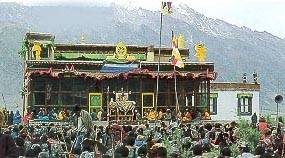 Losar is the most elaborate of all the socio-religious events
of Ladakh. It involves the entire population of the region.
Interestingly, the rites and rituals are a mixture of Buddhist
and pre-Buddhist Bon religious practices. Preparations start
at the end of the harvest period when people start stocking
provisions, sheep and goats for the customary feasts as well
as grain for brewing `chang' (a local barley beer). New
clothes and jewellery are kept ready for the occasion.
Losar is the most elaborate of all the socio-religious events
of Ladakh. It involves the entire population of the region.
Interestingly, the rites and rituals are a mixture of Buddhist
and pre-Buddhist Bon religious practices. Preparations start
at the end of the harvest period when people start stocking
provisions, sheep and goats for the customary feasts as well
as grain for brewing `chang' (a local barley beer). New
clothes and jewellery are kept ready for the occasion.
The festivities start on the 29th day of the 10th month with
the illumination of buildings and shrines. Sheep and goats
reserved for the occasion are ritually slaughtered to begin
the series of evening feasts within families, celebrated in
rotation.
The New Year day itself starts with the offering of votives
and greetings to various gods, elders, relatives and friends.
Afterwards, the elders await the customary visitors who come
to greet the family with presents and `Khatak'(ceremonial
scarf). The younger members go out to visit other families.
Leh and its adjoining villages wear a carnival look as people
dress for the occasion. It is customary for Muslims and
Christians in Leh to visit their Buddhist friends and greet
them on the eve of Losar.
| The Lamas recite mantras
associated with various episodes of Chhams' under the
`Rimpoche's direction, thus creating the right ambience for
devotees to imbibe the religious significance of the dances.
|
| | |
|
Images of ibex and other auspicious symbols are put on the
door, kitchen walls and the central wooden column. The ibex is
a symbol of fertility and is believed to bring prosperity.
Small images of ibex moulded from dough are arranged on
kitchen shelves as good luck charms.
|
In the evening, the `Metho' ceremony takes place. The bazaars
of Leh and the streets of villages are lit up as processions
bearing flaming torches pass, with people chanting slogans to
chase evil spirits and hungry ghosts, believed to be the
result of bad Karma. Whirling torches create a fantastic
display of fire and light. At the end of it all, the torches
are thrown well outside the town to bid farewell to the old
year and to welcome the new one.
GU-STOR
The victory of Black Hat dancers over evil
Gu-Stor literally means `sacrifice of the 29th day',
traditional in the monasteries of the reformist Geluk-pa order
of Tibetan Buddhism. This two-day long festival is held mainly
in the Spituk, Thiksey and Karsha (Zanskar) monasteries, at
different times every year.
The celebration ends with the dismemberment and dispersal of
the `Storma' (sacrificial cake) by the leader of the Black Hat
dancers in a ceremony called `Argham' or `Killing'. This
symbolises the destruction of all forms of evil. And also
re-enacts the assassination of the Tibetan apostate King
Lang-dar-ma, by a Buddhist monk in the mid 9th century. In
some monasteries, an effigy symbolising the stronger force of
evil is burnt at the end of the festival. The masks worn by
the dancers represent the guardian divinities (Dharmapalas) of
the pantheon, and the patron divinities of the Geluk-pa order.
DOSMOCHE
Masked dances in the royal courtyard
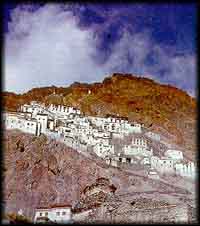 An ancient tradition started by the Kings of Ladakh, Dosmoche
is still celebrated every year in February with great pomp and
fervour. The courtyard of the chapel below the gates of the
Leh Palace come alive with the music of masked lamas from
different monasteries performing the sacred dance-drama. The
lamas prepare, consecrate and eventually destroy the
sacrificial offerings at the climax.
An ancient tradition started by the Kings of Ladakh, Dosmoche
is still celebrated every year in February with great pomp and
fervour. The courtyard of the chapel below the gates of the
Leh Palace come alive with the music of masked lamas from
different monasteries performing the sacred dance-drama. The
lamas prepare, consecrate and eventually destroy the
sacrificial offerings at the climax.
The tantra of `DO' : The lamas of the Takthok Monastery, the
only Nyingmapa foundation of Ladakh, who are experts in
tantric practice and astrology, prepare the elaborate `DO' or
thread crosses - the main objects of offering, which ensnare
all the evil spirits, hungry ghosts and demonic forces when
the prescribed mantras and requisite rites are performed by
the lamas.

The festive procession consists of ten other kinds of
offerings, of different shapes and sizes, complementing the
main offering. These are brought down from the main venue and
carried through the bazaar. Black Hat dancers, followed by
lamas in their religious costumes and the local people in
their resplendent best, make this a spectacular procession.
Musicians and the monastic orchestra lead the way. Outside the
town, the offerings are burnt and destroyed with great fanfare
to wish away all evil spirits and guard against natural
calamities and disasters in the coming year.
|
| The 10th day (Tses-Chu) of the Tibetan lunar month is
celebrated as the birthday of Padmasambhava (Guru Rimpoche),
the founder of Tibetan Buddhism. The Hemis Monastery
celebrates this event in the form of a 2-day festival.
|
| | |
|
Dosmoche celebrations are also held in the Likir (Indus
valley) and Deksit (Nubra valley) monasteries. In Deksit, a
number of folk dances are performed as interludes to the
`Chhams'.
Monastic Festivals
The monastic festivals also provide an opportunity for
socialising, trading and organising outings. A makeshift
market springs up overnight outside the monastic complex.
During the summer festivals, people organise picnics,
overnight excursions, and all-night singing and dancing
parties. The festivals of Ladakh are governed by the Tibetan
lunar calendar.
TSE-CHU
The festival of Padmasambhava
The 10th day (Tses-Chu) of the Tibetan lunar month is
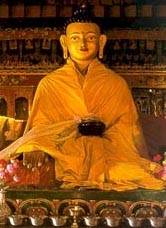 celebrated as the birthday of Padmasambhava (Guru Rimpoche),
the founder of Tibetan Buddhism. The Hemis Monastery
celebrates this event in the form of a 2-day festival. Its
resident lamas perform sacred masked dances leading to the
destruction of sacrificial offerings. Masks worn by the lamas
represent various guardian divinities of the Dugpa order, of
which Hemis is the leading establishment in Ladakh.
celebrated as the birthday of Padmasambhava (Guru Rimpoche),
the founder of Tibetan Buddhism. The Hemis Monastery
celebrates this event in the form of a 2-day festival. Its
resident lamas perform sacred masked dances leading to the
destruction of sacrificial offerings. Masks worn by the lamas
represent various guardian divinities of the Dugpa order, of
which Hemis is the leading establishment in Ladakh.
This 200 year-old tradition was introduced by a member of
Ladakh's ruling family who was reincarnated in the 18th
century as the monastery's Head Lama, 'Sras Rimpoche'. The
Hemis dances are a re-enactment of the magical feats of
Padmasambhava, in his services to the cause of Buddhism in his
eight different manifestations. The festival is particularly
auspicious every 12 years in the Tibetan year of the Monkey,
when the two-storey high Thangka depicting Padmasambhava is
displayed. This famous Thangka, richly mbroidered with pearls
and semi-precious stones, is due to be displayed next in AD
2004.
As the Hemis festival is held during the peak summer season,
it attracts the largest number of people both from within and
outside Ladakh.

MATHONAGRANG
The festival of the blindfolded acrobatic oracle monks
On the 15th day of the 1st Tibetan month, a 2-day festival is
held at the Matho Monastery, the only Saskyapa monastic
establishment in Ladakh. During this festival, the two oracles
of the monastery make a public appearance in their full
spiritual form. These oracles, actually monks of the
monastery, meditate in complete isolation for a full month in
preparation of entering in a state of trace and invoking the
spirit of the deities. On the day of the festival, they invoke
and receive the deities and come into their full spiritual
trance. They run over the high-rise ramparts of the monastery,
jump from one balcony to anther and execute a number of
acrobatic feats, all blindfolded! People from far and wide
come to hear the oracles predict key future events and to seek
answers about their own future.
STOK GURU TSE-CHU
When even laymen can predict the future
Yet another festival of oracles, this is held in Stok, the
present seat of royal residence. The two Stok oracles, unlike
those at Matho, are laymen, spiritually cleansed and prepared
by the lamas of the Spituk Monastery to receive the spirit of
the deities. As in Matho, people repose abiding faith in the
predictions made by the Stok oracles.
PHYANG TSEDUP
Pilgrimage to the Thangka
Phyang is one of the two Dringungpa Monasteries in Ladakh.
This monastery, 17 km west of Leh, holds its festival in
July/August. Like other monastic festivals, sacred
dance-dramas or `Chhams' form the core of this festival. But
the main attraction for the devotees is the pilgrimage to the
huge Thangka of Skyabje Jigten Gombo, founder of the
Dringungpa monastic order, which is kept on exhibition during
the two-day festival.
YURU KABGYAT
An awesome spectacle
This 2-day festival is celebrated in July, in the
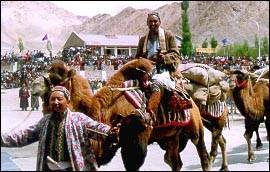 spectacularly situated monastery of Lamayuru, about 127 kms
west of Leh. The masks worn by the lamas during the dances
represent guardian divinities from the Dringungpa pantheon. As
in the case of other monastic festivals, the sacred
dance-drama concludes with the destruction of the sacrificial
offerings. Devotees come by the hundreds to witness the
celebrations.
spectacularly situated monastery of Lamayuru, about 127 kms
west of Leh. The masks worn by the lamas during the dances
represent guardian divinities from the Dringungpa pantheon. As
in the case of other monastic festivals, the sacred
dance-drama concludes with the destruction of the sacrificial
offerings. Devotees come by the hundreds to witness the
celebrations.
GALDAN NAMCHOT
Tsongkhapa's Birthday and Buddhahood
This socio-religious event is celebrated to observe the
birthday and the buddhahood of Tsongkhapa, the Tibetan
saint-scholar who founded the Gelukpa school of Tibetan
Buddhism during the 14th century. The Gelukpa school later
developed as the dominant monastic order in Central Tibet. The
festivities include illumination of all monastic, public and
residential buildings throughout Ladakh. Namchot heralds the
beginning of the New Year celebrations, which continue till
the festival of Dosmoche. During this festival, it is
customary to prepare various varieties of the traditional
dish, thukpa, and serve it to visiting friends and relatives
to mark the festival.
Compiled by Puneet Sachdeva

 `Rimpoche' or Head Lama, incarnate of the monastery. He
occupies a high throne in the centre of the verandah at one
side of the rectangular courtyard. Other lamas sit on either
side of the throne on carpet-covered straw mattresses,
according to their hierarchy. The Lamas recite mantras
associated with various episodes of Chhams' under the
`Rimpoche's direction, thus creating the right ambience for
devotees to imbibe the religious significance of the dances.
According to traditional belief, the appearance of the masked
dancers serves to familiarise the devotees with the kind of
divinities they are expected to encounter during the 49-day,
`Bardo' (or transit) period between death and rebirth in one
of the six forms of existence depending upon one's Karma.
`Rimpoche' or Head Lama, incarnate of the monastery. He
occupies a high throne in the centre of the verandah at one
side of the rectangular courtyard. Other lamas sit on either
side of the throne on carpet-covered straw mattresses,
according to their hierarchy. The Lamas recite mantras
associated with various episodes of Chhams' under the
`Rimpoche's direction, thus creating the right ambience for
devotees to imbibe the religious significance of the dances.
According to traditional belief, the appearance of the masked
dancers serves to familiarise the devotees with the kind of
divinities they are expected to encounter during the 49-day,
`Bardo' (or transit) period between death and rebirth in one
of the six forms of existence depending upon one's Karma.
 Losar is the most elaborate of all the socio-religious events
of Ladakh. It involves the entire population of the region.
Interestingly, the rites and rituals are a mixture of Buddhist
and pre-Buddhist Bon religious practices. Preparations start
at the end of the harvest period when people start stocking
provisions, sheep and goats for the customary feasts as well
as grain for brewing `chang' (a local barley beer). New
clothes and jewellery are kept ready for the occasion.
Losar is the most elaborate of all the socio-religious events
of Ladakh. It involves the entire population of the region.
Interestingly, the rites and rituals are a mixture of Buddhist
and pre-Buddhist Bon religious practices. Preparations start
at the end of the harvest period when people start stocking
provisions, sheep and goats for the customary feasts as well
as grain for brewing `chang' (a local barley beer). New
clothes and jewellery are kept ready for the occasion.
 An ancient tradition started by the Kings of Ladakh, Dosmoche
is still celebrated every year in February with great pomp and
fervour. The courtyard of the chapel below the gates of the
Leh Palace come alive with the music of masked lamas from
different monasteries performing the sacred dance-drama. The
lamas prepare, consecrate and eventually destroy the
sacrificial offerings at the climax.
An ancient tradition started by the Kings of Ladakh, Dosmoche
is still celebrated every year in February with great pomp and
fervour. The courtyard of the chapel below the gates of the
Leh Palace come alive with the music of masked lamas from
different monasteries performing the sacred dance-drama. The
lamas prepare, consecrate and eventually destroy the
sacrificial offerings at the climax.
 celebrated as the birthday of Padmasambhava (Guru Rimpoche),
the founder of Tibetan Buddhism. The Hemis Monastery
celebrates this event in the form of a 2-day festival. Its
resident lamas perform sacred masked dances leading to the
destruction of sacrificial offerings. Masks worn by the lamas
represent various guardian divinities of the Dugpa order, of
which Hemis is the leading establishment in Ladakh.
celebrated as the birthday of Padmasambhava (Guru Rimpoche),
the founder of Tibetan Buddhism. The Hemis Monastery
celebrates this event in the form of a 2-day festival. Its
resident lamas perform sacred masked dances leading to the
destruction of sacrificial offerings. Masks worn by the lamas
represent various guardian divinities of the Dugpa order, of
which Hemis is the leading establishment in Ladakh.
 spectacularly situated monastery of Lamayuru, about 127 kms
west of Leh. The masks worn by the lamas during the dances
represent guardian divinities from the Dringungpa pantheon. As
in the case of other monastic festivals, the sacred
dance-drama concludes with the destruction of the sacrificial
offerings. Devotees come by the hundreds to witness the
celebrations.
spectacularly situated monastery of Lamayuru, about 127 kms
west of Leh. The masks worn by the lamas during the dances
represent guardian divinities from the Dringungpa pantheon. As
in the case of other monastic festivals, the sacred
dance-drama concludes with the destruction of the sacrificial
offerings. Devotees come by the hundreds to witness the
celebrations.